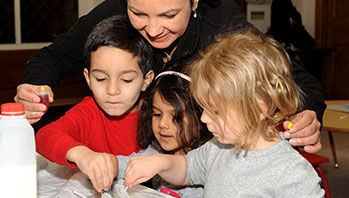- clear cups (2 of one size, 1 of a different size)
- clear plastic bottle
- clear plastic box/cube
- large clear plastic tub
- plastic aprons
- various containers for pouring and filling
- flow
- liquid
- pour
- shape
- squirt
MA Standards:
Language/L.PK.MA.6: Use words and phrases acquired through conversations, listening to books read aloud, activities, and play.
MA Draft STE Standards:
Earth and Space Sciences/Earth’s Systems/ESS2.A: Observe, investigate, and classify the non-living materials, natural and human made, in their environment.
Physical Sciences/Matter and Its Interactions: Structure and Properties of Matter/PS1.A: Describe, compare, sort and classify objects based on observable physical characteristics, uses, and whether it is manufactured as part of their classroom play and investigations of the natural and human-made world.
Head Start Outcomes
Logic and Reasoning/Reasoning and Problem Solving: Classifies, compares, and contrasts objects, events, and experiences.
Science Knowledge/Conceptual Knowledge of Natural and Physical Worlds: Observes, describes, and discusses properties of materials and transformation of substances.
PreK Learning Guidelines:
English Language Arts/Language 2: Participate actively in discussions, listen to the ideas of others, and ask and answer relevant questions.
Science and Technology/Earth and Space Sciences 5: Compare and contrast natural materials such as water, rocks, soil, and living organisms using descriptive language.
Science and Technology/Physical Sciences 19: Explore, describe, and compare the properties of liquids and solids found in children's daily environment.
Small Group: No Shape of Its Own

© Commonwealth of Massachusetts, Department of Early Education and Care (Jennifer Waddell photographer). All rights reserved.
STEM Key Concepts: Water takes the shape of its container; The same amount of water fills the same container to the same height; The same amount of water fills containers of different shapes and sizes to different heights; You can use different objects to move water
Educator Prep: Before beginning the activity, fill the large tub with about four inches of water. Put clear containers of different shapes and sizes in the water. Place the tub on a low table so children can reach the water.
Safety Tips:
- Remind children to wash their hands before and after the activity.
- If you work outside, be aware of and check for poison ivy, poison sumac, and thorny or prickly bushes before gathering children in a designated area.
Remind children of their earlier water explorations and how they poured and squirted water and observed its flow. Introduce the word liquid, and tell children that liquids, like water, flow. Ask children to name some other liquids they know. (water, milk, juice)
Next tell children that they are going to explore the idea that liquids, such as water, do not have their own shape. As you pour the water from one container to another, encourage children to notice its shape and its level (how high it is) in each of the differently sized and shaped containers.
- Hold up a clear plastic box and ask children to describe its shape. (square)
- Pour some water into the box, encouraging children to observe how it flows and settles in the box. Ask children to describe the shape the water takes. (square)
- Pour the water from the box into a plastic cup and ask, Is the water still the shape of the square box? What shape does it have now?
- Pour the water from the cup into a water bottle and ask, Now, what shape is the water?
- Summarize the discussion by saying that liquids, such as water, do not have their own shape, but always take the shape of their containers.
Invite children to pour water into containers of different shapes and sizes. Encourage them to notice and describe the shape water takes, and its level, in different containers.
Take it Further: Have children explore how a cup of water fills the same container to the same height every time you fill it. Then explore how the water fills containers of different sizes and shapes to different heights. Encourage children to pour and fill, discussing what happens when they pour water from a large container into a small container, from a small container into a large container, and between containers of the same/different size and shape.
